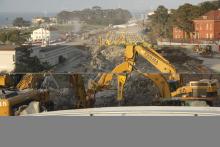
The iconic Golden Gate Bridge in California is now benefiting from the introduction of a new moveable barrier.
Supplied by US specialist
Constructed in the 1930s and first opened to traffic in 1937, the Golden Gate has coped extremely well with the years. Soundly engineered, it has withstood earthquakes as well as a massive increase in vehicle traffic volumes. The bridge currently carries average traffic on I-101 of some 110,000 vehicles/day, with that volume projected to rise to 138,000 vehicles/day by 2038. Maximising the capacity of the bridge, which carries heavier commuter traffic flows into San Francisco in the morning, and greater volumes out of the city in the evening, was seen as vital. Also crucial was the need to improve safety for vehicle occupants using the bridge, due to the lack of a centre lane dividing barrier.
Since 1970 there have been 16 fatalities and 128 head-on collisions on the crossing. Strict enforcement of the 72km/h speed limit over the crossing and improved vehicle safety have helped ensure there have been no fatalities since 2001, but some drivers have still suffered serious and life-changing injuries in that period.
But with the commissioning of the moveable barrier, there will be no ‘suicide lanes’ in the centre of the crossing, which many drivers feared to use due to the risk of possible head-on crashes. The opposing traffic flows were previously separated only by yellow plastic tubular markers and although these provided delineation, they were unable to prevent crossover crashes should the driver of a vehicle lose control.
Previously the bridge was able to carry three lanes of traffic in either direction. The use of the new machine means that the bridge retains six lanes in all, but can up to four in one direction and two in the other, to better cope with daily commuter traffic needs. Lane widths have been reduced slightly, but the authorities say that with the new barrier and ensuring vehicles stick to the speed limit will help minimise the risk of incidents.
Measuring around 3.5km long, the moveable barrier extends for the length of the bridge and onto its approaches on either side. A lower speed limit on one of the approaches also helps safety.
The new moveable barrier is the very latest version of the system from Lindsay Transportation Solutions, featuring hinged steel and concrete sections rather than the precast concrete components used previously. According to the firm, the new steel sections retain the proven hinge design and provide the same level of safety for vehicle users as the earlier version.
Called the Road Zipper due to the way it operates, the machine operates at 16km/h and can quickly lift and move a central dividing barrier over to the desired location. The Road Zipper System moveable barrier concept is used on other contraflow managed lanes where a movable median is not practical. It has been well-proven over many years as it was first introduced in 1985 and is now in use at several other major bridges, including the Auckland Harbour Bridge in New Zealand and the Ben Franklin Bridge in Delaware.
The total project, including research, engineering, the Road Zipper machines, the barrier, and site work, cost $30 million. This installation has been paid for from a number of sources with the, majority, $20 million, coming from the State of California.
Martin Leak, managing director of Resolve Group, attended the installation and opening ceremony for the Golden Gate Bridge Moveable Median Barrier (MMB). This milestone installation has been in planning for nearly 30 years. The bridge was closed for the installation and ceremony. Among those attending, a survivor of a 2008 head-on crash on the bridge gave a speech from her wheelchair, inaugurating the new barrier.
Leak has a long association with these systems. He installed the original moveable barrier system on the Auckland Harbour Bridge in 1990, new upgraded barriers a few years ago, a new system in Sydney, Australia in 2012. Resolve Group worked with the client and Barrier Systems to develop solutions through to installation and operation of the systems.













